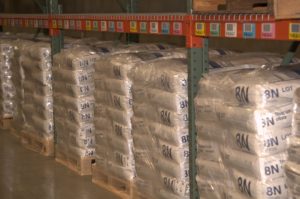
![]() Companies that store and distribute food products must go through programs and implement procedures that most warehouses may overlook. Although the food business can be lucrative and rewarding, following all of the special requirements to ensure your food handling business is in compliance can be quite costly and time consuming. Whether you are maintaining your own facility or using a third party logistics provider to carry out your supply chain function as a food product distributor, you need to consider the following:
Companies that store and distribute food products must go through programs and implement procedures that most warehouses may overlook. Although the food business can be lucrative and rewarding, following all of the special requirements to ensure your food handling business is in compliance can be quite costly and time consuming. Whether you are maintaining your own facility or using a third party logistics provider to carry out your supply chain function as a food product distributor, you need to consider the following:
Certification Program– Being coined as a Food Grade Warehouse starts with becoming certified. One of the most common certifications is awarded by the American Institute of Bakers (AIB) International. The AIB provides audits and educational opportunities for maintaining food grade status. There are key areas that audits such as the one performed by AIB focus on, and we will go over some of the primary ones below.
Temperature Control– Not all food products need to be temperature controlled. Dry storage warehouses can be ambient whereas frozen and refrigerated (30-39 degrees F) items need to be in temperature controlled environments. The primary reason for controlling the temperature of certain items such as meats and poultries, fruits and vegetables, and dairy products is to avoid contamination and pathogen growth.
Building and Land Maintenance- There are several areas of a food grade facility that should be maintained in order to pass a certification program. The warehouse should be sealed and the building should be free of openings from cracks in walls, damaged dock doors, leaky roofs and broken pipes. Furthermore, a pest control management system must be integrated and the surrounding landscaping kept in good condition.
Inventory Control– There must be a system in place to manage inventory on a first in first out basis. A good warehouse management system should ensure that the products that come in first will be the first to leave- although the system is only as good as its operators. Lot control is one way to keep track of food manufactured in batches and helps to ensure FIFO is followed.
FDA Registered vs. FDA Certified – A common fallacy for warehouses that store food is that the facility must be FDA certified. The FDA requires facilities distributing food to be registered with the FDA, however, facilities do not get certified or approved. The registration process is simple and accessible, it just needs to be done. Here is a good resource released by the FDA on the subject of understanding the differences between FDA Registered and Certified.
Systems and Procedures- A food grade auditor will very likely want to see systems and procedures the company has in place to keep the facility maintained and team members trained in proper food handling techniques. This includes having assigned locations for MSDS and other important safety documentation. Safety precautions also should be documented and emergency exits posted for all employees and other guests in the facility.
Although these items above may seem overwhelming, and there is much more to it, you don’t have to do it on your own. If you run a company that sells food grade products, you might want to consider starting off or expanding with a third party food grade warehouse. Interested in finding a food grade logistics partner that can store and distribute your products? Contact Us to get started!
Interested in learning more about 3PL fundamentals and Flex updates? Subscribe to our newsletter!
Copyright © 2024 Flex Logistics, Inc.
Website Developed by Raincross
